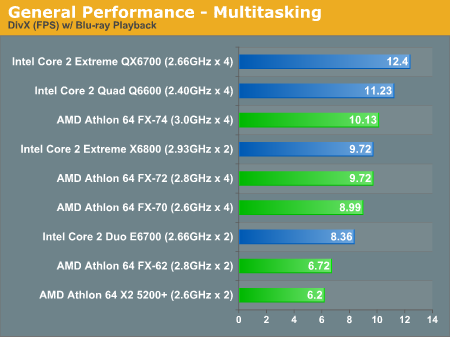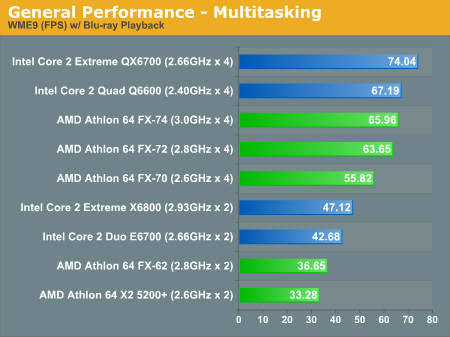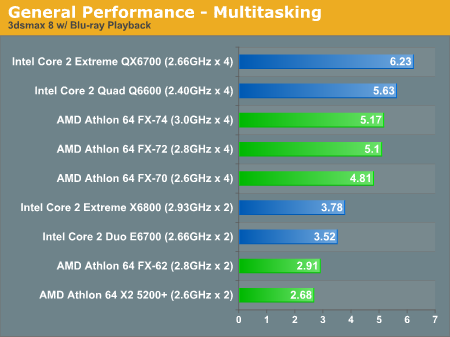AMD's Quad FX: Technically Quad Core
by Anand Lal Shimpi on November 30, 2006 1:16 PM EST- Posted in
- CPUs
Multitasking Performance
When we were trying to think up new multitasking benchmarks to truly stress Kentsfield and Quad FX platforms we kept running into these interesting but fairly out-there scenarios that did a great job of stressing our test beds, but a terrible job and making a case for how you could use quad-core today.
Without a doubt, in the next two years the number of applications that see a benefit when running on four cores will increase dramatically. Even multitasking under Windows Vista will make the argument for more cores easier (simply opening a new Explorer window in Vista will eat up 10% of the CPU time of a Quad FX system), but our Vista benchmarks are not yet complete and we wanted to have something to showcase for this review.
While working on our Quad FX article we also happened to be working on a follow-up to our HDCP Graphics Card Roundup, focusing on H.264 decoding performance in Blu-ray titles. A light bulb went off and we had our benchmark: how many cores do you need to watch a high bit-rate Blu-ray movie and do something else at the same time on your PC?
The movie we used was Xmen III, encoded in H.264, and featuring bitrates in excess of 40Mbps at times. Our benchmark starts at the beginning of Chapter 18 and continues until our background tasks are complete. This particular segment ranges in bitrate from 13Mbps up to above 40Mbps, with the average falling in the 18 - 24Mbps range.
We played the movie in the foreground, while in the background we either ran our Cinebench test, encoded a DivX movie, encoded a WME9 movie or performed our 3dsmax test.
The two rendering tests are important because rendering can take a bit of time and it might be nice to entertain yourself with a movie while your rendering completes; after all, what's the point of having $1000 worth of CPUs if you can't use them for entertainment?
The two encoding tests are also important because being able to encode and decode at the same time is a fundamental requirement for a DVR, and at some point the next-generation of media center PCs will need to be able to decode high bitrate HD movies while encoding others. We chose to include both DivX and WME because DivX runs much better on Intel CPUs, while the standings are a bit closer under WME, to give you a better overall impression of how the two platforms handle these heavy multitasking scenarios.
Our first test involved us playing back the BD title while running our multi-threaded Cinebench test; we reported the Cinebench score upon its completion:

The dual core processors all fall to the bottom of the list and basically perform like single-core CPUs while decoding the Blu-ray movie. The quad-core setups do much better and perform very well, but all of the CPUs in this test were able to run without dropping any frames in the BD movie.
Making things a bit more difficult, our next test had the same movie playing back but this time we ran our DivX encoding test in the background. We reported the DivX encoding frame rate upon completion:

Performance is pretty much what you'd expect, although Intel's superior DivX encoding performance results in the Core 2 Extreme X6800 doing almost as well as the FX-74. What you don't see however is how well these systems played back the Blu-ray movie; none of the dual core setups were able to play the BD movie smoothly, not even the Core 2 Extreme X6800. The movie was basically unwatchable due to all of the pausing and stuttering.
All of the four core systems played the BD movie fairly well; although they all dropped some frames, it wasn't enough to totally ruin the experience.
Next up we tried playing our BD title while running our WME9 test, and found similar results:

Once again, none of the dual core platforms were able to play the BD title even remotely smoothly. The quad-core setups were able to play the movie while encoding, but still managed to drop some frames (not enough to ruin the experience though).
Our final multitasking test has us playing the same BD title while running our 3dsmax 8 render test:

Much to our disappointment, none of the systems could handle this workload without ruining the movie playback; even the quad-core setups had troubles. We're not talking a few dropped frames, but rather the movie playback would be completely stopped at times. It looks like we may have a scenario for either more GPU assisted H.264 decode or an 8-core Quad FX platform in the future.










88 Comments
View All Comments
JarredWalton - Friday, December 1, 2006 - link
Yay for speech recognition!indigenous = enthusiast
we are see = we are seeing
Scratch a couple "basically" from the last paragraph.
yyrkoon - Friday, December 1, 2006 - link
I though Gary was the "one" with the Texas "Twang" ;)laok - Thursday, November 30, 2006 - link
The current 4x4 does not look to be a mature system to me. Wait until 65nm 4x4 comes out and hopefully a better chipset will be available at that time. 65W x 2 is reasonable, 130W x2 is kinda too much.And I also want to know how 4x4 compares to dual dual-core opteron with the same frequence: performance, power consumption etc.
DigitalFreak - Thursday, November 30, 2006 - link
It's the same chip as the Opteron, with the memory controller changed to work with unbuffered memory.JarredWalton - Friday, December 1, 2006 - link
The first word of his subject is the best advice: WAIT! Even if the future might get better, does anyone want to spend $1000+ on what may or may not turn out to be the better platform? When the new CPUs are available, then we can evaluate and decide. Of course, once AMD launches their quad core processors, I'm almost certain that our advice will be that most people only need a single socket motherboard and CPU anyway -- if that. Many people still get by a single core CPU, and the number of people that actually need more than dual CPUs is very small, at least in the desktop workspace.DigitalFreak - Thursday, November 30, 2006 - link
This is the best AMD can do against Kentsfield? They get stomped on in every benchmark, cost more, and draw nearly twice as much power. No one in their right mind would buy this over a Core2Quad. Whomever came up with this product should be fired.The last time I laughed this hard at a CPU/platform launch was when Intel rolled out the P4 dual core CPUs, and at least they came out on time in some of the multimedia benchmarks.
For the record, my current system is running an Opteron 165, so I ain't no Intel fanboy.
photoguy99 - Friday, December 1, 2006 - link
You're right it's actually embarrasing isn't it?If AMD's next-gen architecture improves performance by 30% at same clock, which is huge, they still won't take the lead.
And it seems Intel is done sitting on their hands, they are working like hell to dominate again by the time K8L ramps up big.
People hate hearing this but think it's over for AMD.
And like you, for the record, my current system is an FX-60 so I'm also no Intel fanboy.
DigitalFreak - Thursday, November 30, 2006 - link
...came out on top...photoguy99 - Thursday, November 30, 2006 - link
Seriously, I'd like to know who is selling them...Furen - Thursday, November 30, 2006 - link
That such a badly engineered product was rushed out to reviewers just to have a paper launch. Did AMD believe that no one would make a big deal about the power draw? Or maybe it expected no one to even look at power draw. I was actually impressed by what AMD had accomplished with 4x4, after all, the 3.0GHz Quad FX parts were close to the QX6700, until I saw the insane power draw. Two loaded FX-62 systems (whole systems, mind you) draw about the same power as 4x4 does IDLE!